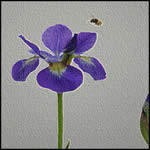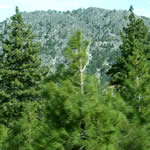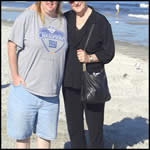Gary's Parries 21/05/06
 This week’s Gary’s Parries topics are:
This week’s Gary’s Parries topics are:
1. Nikon D70 Front-Focused Images (Part III)
2. How To Achieve Smaller Image Files
3. Busy As A Bee
Introducing this week’s Gary’s Parries column. Everything you always wanted to know about digital cameras, but were afraid to ask. No question too difficult, or too easy. As a Senior Principal Software Engineer, and a former Assistant Professor of Computer Information Systems, as well as a recording studio owner/operator, and now, a digital camera enthusiast, GARY has more digital camera knowledge in his entire brain than most people have in their little finger. In the unlikely event that GARY would not know the answer to your question, he will answer it anyway, true to the spirit of the word “Parries”, a fencing term which, in this context, implies “cleverly evasive answers”. So let your imagination run wild. Email all your nagging digital camera questions to: [email protected], and then, En Garde!
You may also attach to your email an ORIGINAL PHOTO of your choosing. A preview of the photo will be displayed with your question, and a full-sized version will be just a click away. No personal information will be published with your question unless you specifically include it in the text or attached photo of your email, which may be further edited for grammar, content, or other reasons.
***
*** QUESTION 1—- NIKON D70 FRONT-FOCUSED IMAGES (PART III)
***
Once again I must prostrate myself before your infinite wisdom… Sadly, I was following the correct procedure with the focus and recompose, because with the AE-L/AF-L button set to ‘Focus Only’ the camera will ONLY focus when the button is pressed. There are, however, issues surrounding that technique when the DOF is small.
I think there are 2 issues for me: one is that the 17-55 2.8 is a wrong’un. I’ve since tried it with the D2Hs, and it still buggers it up. Back to Nikon it is.
My 85 1.4, however, just shines with the D2Hs, even in very dark conditions. Focusing is so much better (than the D70), even at 8 fps! AWB is significantly better, too. I’ve tried the Canon 5D now, with a selection of lenses - and I wasn’t as impressed as I expected I’d be. For still subjects, it’s amazing - but for moving ones, the D2Hs nails it more often. There’s no point having 12 million pixels if you don’t get the shot. Noise control is better than the D2Hs, but not, I think, significantly. The D2Hs noise converts to B/W beautifully, like Tri-X.
I think I’m talking myself into the ridiculously expensive, sure-to-be-replaced-by-an-8MP-D3H-in-September, what-the-hell-am-I-going-to-say-to-the-wife D2Hs… :)
Cheers,
Rupert
***
*** ANSWER 1
***
Rupert, I hope you are not in a big rush to buy that D2Hs. I am convinced your Nikon D70’s front focusing problem can be resolved. As I am sure you are aware, there have been reported front focusing problems with the D70, as well as back focusing problems (see photo). These can be attributed to camera malfunction, lens malfunction, and/or operator error.
The fact that you said your F2.8 17-55mm lens was working improperly on the D2Hs leads me to believe that the lens may be the cause of your front focusing. Have you noticed the same problem with your F1.4 85mm lens? If so, have you tried checking your camera using a front/back focus test chart, as is readily available for download off the Internet?
I would also like to eliminate the possibility that your D70 is somehow reverting to its Closest Subject focusing mode. Could you please set the D70’s Custom Setting 2 to the AF-S option and its Custom Setting 3 to the Single Area option (see pages 139 and 140 of the user’s manual), and then verify there is no change in the focusing symptoms?
Your operational description of pressing and then releasing the D70’s AE-L/AF-L button to lock the focus sounds perfectly logical, but it is the opposite of the description in the D70 user’s manual, which states that, with Custom Setting 15 set to its AF Lock Only option, the D70’s focus locks “while” the AE-L/AF-L button is pressed. Your description sounds more like the Custom Setting 15 AF-ON option, which states that the D70 focuses “when” the AE-L/AF-L button is pressed, and does NOT focus when the shutter-release button is pressed halfway. Could you please verify which Custom Setting 15 option you are using (see page 147 of the user’s manual)?
As if this weren’t already enough to take into account, we must also consider that the composition of the image could be contributing to the problem. Do you have some sample images you could provide for use in the column?
One last request. I would hate to think that, once we do get to the bottom of this D70 problem, you may still be inclined to upgrade to a D2Hs anyway, simply for its higher performance features. BTW, my guess is July 2006 for the D3H. :)
[Note: Thanks to [email protected] for his continued D70 support. – Ed.]
***
*** QUESTION 2—- HOW TO ACHIEVE SMALLER IMAGE FILES
***
I wonder why different cameras with similar number of pixels differ so much in the size of their picture files? It doesn’t seem to be related to sharpness. For example, the Pentax Optio A10 is sharp per pixel, but has very small files in comparison with the Canon PowerShot S80, which is about as sharp. The Casio Exilim EX-Z850 and Nikon Coolpix P3 are less sharp, but have even bigger files.
Regards,
Anders Tiberg
***
*** ANSWER 2
***
Anders, there are several factors which could have caused the 8 megapixel cameras you’ve mentioned to have quite different file sizes. The most dominant of these factors is the JPEG quality level used by the cameras for compressing their images. Manufactures label their JPEG quality level settings with descriptive names such as Superfine, Fine, Normal, etc., but there is no direct correlation between these subjective names and their actual quantitative JPEG quality level values.
Another factor that can affect the image file size is image content. In particular, for a given JPEG quality level, an image with smoothly changing hues will compress much more efficiently (i.e., smaller file size) than an image with abrupt hue changes. The sharpness of an image, and similarly the noise content of an image, can have an adverse affect on the image’s file size, simply because those attributes have a negative impact on the image’s smooth hue transitions.
However, as you noted with the above cameras, their image sharpness did not seem to correlate with their file size. That is because the effect of their image sharpness was masked by the much more predominant effect of their chosen JPEG quality level used for image compression.
The reason why the Pentax Optio A10 has one of the smallest 8 megapixel file sizes is because it uses one of the lowest JPEG quality levels for its image compression. Conversely, the reason why the Casio Exilim EX-Z850 has one of the largest 8 megapixel file sizes is because it uses one of the highest JPEG quality levels for its image compression. The Canon PowerShot S80 uses a similarly high JPEG quality level; however, I suspect it is a lot less noisy than the Casio EX-Z850, hence its smaller file size.
***
*** QUESTION 3—- BUSY AS A BEE
***
 My medium format, and smaller slides and negatives are kept in the same dark, air-conditioned room as my camera collection. Less dense reversals of the early ‘80s are beginning to become obviously lesser in density. I have quite a project awaiting me with scanning/ storing. Gotta decide on a scanner soon, too busy taking pictures.
My medium format, and smaller slides and negatives are kept in the same dark, air-conditioned room as my camera collection. Less dense reversals of the early ‘80s are beginning to become obviously lesser in density. I have quite a project awaiting me with scanning/ storing. Gotta decide on a scanner soon, too busy taking pictures.
Semper Fi,
Nick and Family
P.S. Here are a few pictures from this morning (20 per day keeps the doctor away).
***
*** ANSWER 3
***
Nick, I can sympathize with all the work you have ahead to preserve your film archives. It’s a shame digital did not come of age sooner. In view of your predicament, I thought this story might cheer you up.
My great-grandfather, Hugo Pogoda, was a professional photographer who was ahead of his time. He realized that his precious photographs would degrade with age, so he devised a way to manually ‘digitize’ them.
He created a set of 1024 grayscale flash cards, ranging from pure black with a value of 0, to pure white with a value of 1023. He also built a photo enlarger to project his images onto a 10’ by 10’ white wall having a lightly marked grid of approximately 2000 by 2000 one-sixteenth inch squares. With an image projected on the grid, he would compare each square to his grayscale flash cards, and record the numeric value that most closely matched the square’s level of gray.
At first he recorded the numeric values on standard parchment, but he later found a way of adding a bit of gold leaf to his parchment, making it far more durable and long lasting, so much so that the information is still intact today, with no special storage conditions required.
In an effort to continue with the preservation of these archives, I was able to scan my great-grandfather’s parchments into a computer using text recognition software, and store the information as a 10-bit, 4 megapixel RAW format. I was then able to read the RAW format into my GraphicConverter software application and print the resulting images on an InkJet photo printer. Even though his photos were shot more than 120 years ago, they look as though they were shot yesterday with a high quality DSLR.
As an aside, while my great-grandfather was in the process of recording the grayscale image values from the 10-foot high grid, he needed a way to quickly boost himself to view the upper portions of the grid, so he devised a spring-loaded platform with a pole grip for easily bouncing himself up to the required level. This bouncing platform caught on with the neighborhood kids, and he was soon approached by a local bicycle manufacturer to produce the device, calling it the Hugo Pogoda Pole, which was later changed to the Hugo Pogoda Stick, then shortened to the Pogoda Stick, and then simply to the Pogo-Stick. :)
***
[Column photo “The Photographer” by Brenda LaFleur of Brenda LaFleur Photography.]


